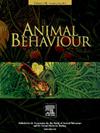Hard exoskeleton of beetles as armour against avian predators
IF 2.3
2区 生物学
Q2 BEHAVIORAL SCIENCES
引用次数: 0
Abstract
The robust exoskeleton of beetles, Coleoptera, is believed to have protective advantages, contributing to their evolutionary success. However, empirical evidence of the defensive capabilities of this exoskeleton remains surprisingly scarce. Here, we demonstrate the critical role of the robust beetle exoskeleton in protecting against avian predation. We found that flower chafers (Scarabaeidae, Cetoniinae) have more robust bodies than other scarab species. Laboratory experiments with naïve Japanese quail, Coturnix japonica, revealed that some individuals of intact Cetoniinae survived attacks without serious injury, whereas all individuals of soft scarab species or elytra-removed Cetoniinae were consumed. The survival rate of intact Cetoniinae increased in complex environments because the combination of their stiffness and elliptical shape made it difficult for quail to handle the prey. Field experiments with wild white-cheeked starlings, Sturnus cineraceus, and Eurasian tree sparrows, Passer montanus, demonstrated that most individuals of Cetoniinae species were ignored, whereas soft species were readily preyed upon. Further, when we presented the starlings with the Cetoniinae species Protaetia orientalis that had artificially softened bodies and altered appearance, the starlings readily preyed upon them. This observation suggests that P. orientalis is not chemically defended. Moreover, wild birds can visually discriminate hard species because of prior experience with the unprofitable prey. These results collectively provide evidence that the robust exoskeleton of beetles protects them from predatory attack.
甲虫的坚硬外骨骼是抵御鸟类捕食者的盔甲
甲虫(鞘翅目)坚固的外骨骼被认为具有保护优势,有助于它们在进化过程中取得成功。然而,有关这种外骨骼防御能力的实证证据仍然少得令人吃惊。在这里,我们证明了坚固的甲虫外骨骼在抵御鸟类捕食方面的关键作用。我们发现花糠金龟(Scarabaeidae,Cetoniinae)的身体比其他金龟子物种更加坚固。用天真无邪的日本鹌鹑(Coturnix japonica)进行的实验室实验表明,一些完整的花蟾科个体在受到攻击后存活下来,没有受到严重伤害,而所有软体猩红蝶物种或被切除外骨骼的花蟾科个体都被吃掉了。在复杂的环境中,完好无损的Cetoniinae的存活率会增加,这是因为它们的硬度和椭圆形的结合使得鹌鹑很难处理这些猎物。用野生白颊椋鸟(Sturnus cineraceus)和欧亚树麻雀(Passer montanus)进行的野外实验表明,大多数Cetoniinae种类的个体都会被忽略,而软体种类则很容易被捕食。此外,当我们向椋鸟展示人工软化身体和改变外观的Cetoniinae物种Protaetia orientalis时,椋鸟很容易捕食它们。这一观察结果表明,东方椋鸟没有化学防御能力。此外,野生鸟类可以通过视觉来辨别坚硬的物种,因为它们以前曾捕食过无利可图的猎物。这些结果共同证明,甲虫坚固的外骨骼可以保护它们免受捕食性攻击。
本文章由计算机程序翻译,如有差异,请以英文原文为准。
求助全文
约1分钟内获得全文
求助全文
来源期刊

Animal Behaviour
生物-动物学
CiteScore
4.60
自引率
8.00%
发文量
236
审稿时长
10.2 weeks
期刊介绍:
Growing interest in behavioural biology and the international reputation of Animal Behaviour prompted an expansion to monthly publication in 1989. Animal Behaviour continues to be the journal of choice for biologists, ethologists, psychologists, physiologists, and veterinarians with an interest in the subject.
 求助内容:
求助内容: 应助结果提醒方式:
应助结果提醒方式:


